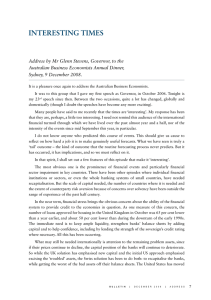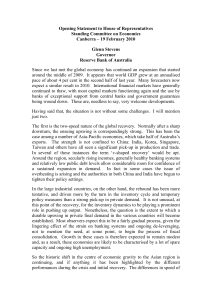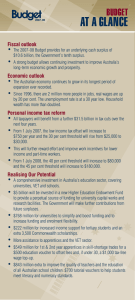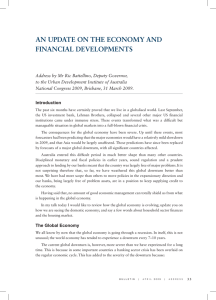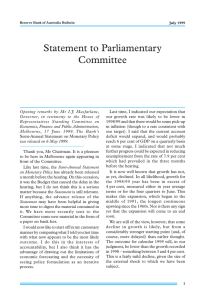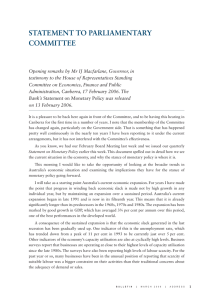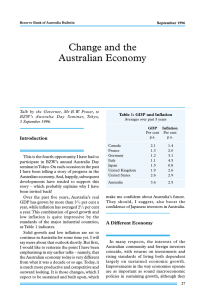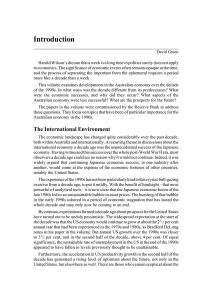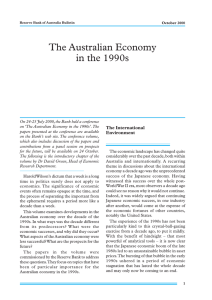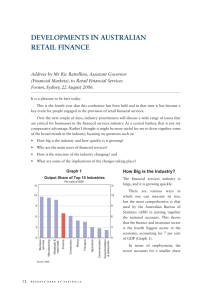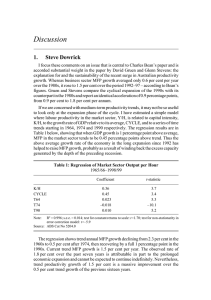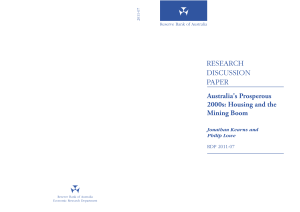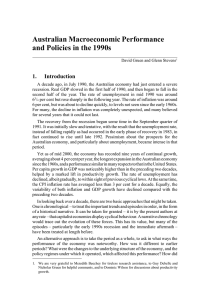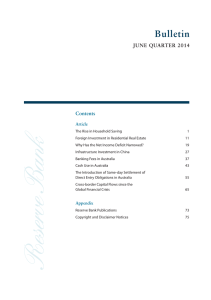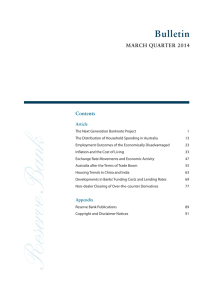THE DIRECTORS’ CUT: FOUR IMPORTANT LONG-RUN THEMES
advertisement
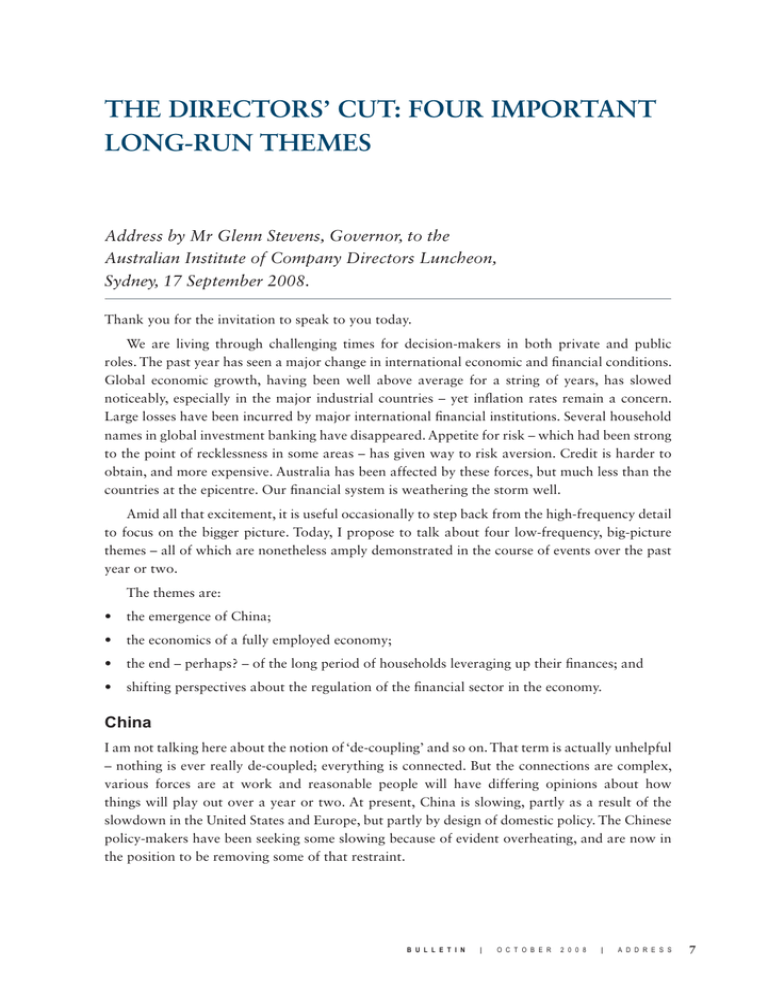
THE DIRECTORS’ CUT: FOUR IMPORTANT LONG-RUN THEMES Address by Mr Glenn Stevens, Governor, to the Australian Institute of Company Directors Luncheon, Sydney, 17 September 2008. Thank you for the invitation to speak to you today. We are living through challenging times for decision-makers in both private and public roles. The past year has seen a major change in international economic and financial conditions. Global economic growth, having been well above average for a string of years, has slowed noticeably, especially in the major industrial countries – yet inflation rates remain a concern. Large losses have been incurred by major international financial institutions. Several household names in global investment banking have disappeared. Appetite for risk – which had been strong to the point of recklessness in some areas – has given way to risk aversion. Credit is harder to obtain, and more expensive. Australia has been affected by these forces, but much less than the countries at the epicentre. Our financial system is weathering the storm well. Amid all that excitement, it is useful occasionally to step back from the high-frequency detail to focus on the bigger picture. Today, I propose to talk about four low-frequency, big-picture themes – all of which are nonetheless amply demonstrated in the course of events over the past year or two. The themes are: • the emergence of China; • the economics of a fully employed economy; • the end – perhaps? – of the long period of households leveraging up their finances; and • shifting perspectives about the regulation of the financial sector in the economy. China I am not talking here about the notion of ‘de-coupling’ and so on. That term is actually unhelpful – nothing is ever really de-coupled; everything is connected. But the connections are complex, various forces are at work and reasonable people will have differing opinions about how things will play out over a year or two. At present, China is slowing, partly as a result of the slowdown in the United States and Europe, but partly by design of domestic policy. The Chinese policy-makers have been seeking some slowing because of evident overheating, and are now in the position to be removing some of that restraint. B U L L E T I N | O C T O B E R 2 0 0 8 | A D D R E S S 7 But the emergence of China as an industrialised economy is a fundamental long-term change to the economic, financial and political landscape whose full consequences I suspect we can barely appreciate as yet. This has been happening for a couple of decades now, but the nature of its impact is gradually changing. For some years, it was too small to notice – even a country with a lot of people is small economically if their per capita incomes and productivity are very low. Then, some time in the 1990s, China became quantitatively important enough for the rest of the world to enjoy the disinflationary effects of added Chinese production capacity, as millions of low-cost workers turned out manufactures, in the process lowering global prices. More recently, we have been experiencing a new effect of that growth, namely the effect of higher Chinese living standards on the price of energy and natural resources. Of course, this is not confined to China – it is happening around the developing world to a greater or lesser extent. But China is the biggest example. Commodity prices are coming off their peaks at present, though key prices for Australia are still very high. Even if this marks a cyclical turn for such prices, in the longer term this new claim on energy and other resources will not go away. Other countries are having to adapt to that. The rise in prices for energy and raw materials has made it harder for those countries to combine the steady growth and low inflation that had characterised the period from the early 1990s until about the middle of this decade. At the same time, this extraordinary increase in the demand for natural resources and energy has raised Australia’s terms of trade by close to two-thirds in the space of five years – the largest shock of its kind for five decades. So the economics of this for Australia are therefore a bit different from those for the ‘average’ industrial country. Like others, in the energy-using parts of the economy, we find it more difficult to combine steady growth and low inflation. But in addition, we have had to absorb a massive income boost.1 Of course, there are worse problems to have! Nonetheless, significant adjustments are occurring – to the structure of the economy, to where the population lives and how the national income is earned and distributed. Unless resource prices reverse a long way, these trends will continue. China’s emergence is surely far from complete. China, like all economies, will have cycles. But its average growth rate is likely to be pretty high for years ahead, even if not as high as it has been recently. This is an opportunity and a challenge for Australian business and policy-makers, and not just in the resource sector. Economics of Full Employment Over recent years, the Australian labour market has been as tight as at any time seen in a generation. The rate of unemployment in the past 12 months, at about 4 per cent, has been as low as at any time since 1974. In surveys and our discussions with firms, difficulty securing labour has been a common problem. The term ‘capacity constraint’ has been a part of the Australian economic lexicon over recent years in a way not seen for a long time. Survey measures of capacity utilisation have been very high, and fixed investment to increase capacity is running strongly. 1 For those of you who are interested, I have set out my views on this in an earlier address. See <http://www.rba.gov.au/ PublicationsAndResearch/Bulletin/bu_jul08/com_prices_macro_pol_aus_perspective.html>. 8 R E S E R V E B A N K O F A U S T R A L I A Let’s be clear that full employment is a good thing. It is one of the statutory objectives given to the Reserve Bank in our Charter (though interestingly the authors of the Act never quantified what they meant by full employment, nor for that matter, by ‘stability of the currency’). But the economics of full employment are different from the economics of trying to get to full employment. This is a simple point, but an important one. When the economy has too much spare capacity – say, in the aftermath of a business cycle downturn – the aim of macroeconomic policies is to push up demand so that it catches up to supply potential. There may be several years in which demand growth exceeds the normal pace as it eats into the spare capacity. Once the spare capacity has been wound in, however, actual growth in demand and output has to slow, to match the growth rate of potential supply. That growth in potential supply is given by the growth in the labour force, the capital stock and the productivity of those factors of production. Typically we think of ‘potential GDP’ in Australia rising by something like 3 per cent a year, give or take a bit. This, as my predecessor Ian Macfarlane remarked a few years ago, means that once the reserves of spare capacity are pretty much used up, we should expect to be accustomed to growth rates for GDP starting with a 2 or a 3. There will not be many with 4s or 5s, as we had for some years through the 1990s and earlier this decade. Periods of growth noticeably above about 3 per cent will be roughly matched in frequency and duration by periods below – as we are having now. If we set our aspirations higher than that – if we try for above-average performance all the time – we will just get inflation. That is the economics of full employment. Now you may feel that a growth rate for real GDP of something like 3 per cent on average is not that high. Is that the best we can do? Can’t we lift it? The only way the potential growth rate can be lifted is by adding more factors of production – more labour and capital – or raising the growth rate of productivity. Over the long term, the key is productivity. On that front, productivity growth does seem over the past several years to have settled at a lower average rate than we had seen since the early 1990s. This may have several causes, and the experts debate them. But over the years ahead, as a community we must be sure not to let up on our efforts to keep productivity growing. I have no specific policy prescriptions here – only general ones – trying to sustain competition, to keep markets open, to maintain flexibility and so on. But those general values are worth recounting from time to time. Household Balance Sheets A feature of the economic landscape of the past decade and a half has been the long gearing up of households. In the early 1990s, household gross debt in Australia was equal to about 50 per cent of average annual household disposable income. This year, it reached about 160 per cent. Households’ assets rose generally in parallel, though not quite as fast, with total assets rising from about 460 per cent of income in 1990 to over 800 per cent at the end of 2007. (Assets have fallen somewhat since then, with the decline in the share market and some softening in housing prices.) The ratio of debt to assets rose from under 10 per cent in 1990 to about 18 per cent in 2008. The ratio of housing debt to housing assets reached about 27 per cent. B U L L E T I N | O C T O B E R 2 0 0 8 | A D D R E S S 9 Very similar trends have been seen in a number of comparable countries around the world, so in thinking about the causes, we should not look exclusively for domestic causes. But in summary, the main factors behind this big increase in the size of the household sector’s balance sheet were: • the general tendency for financial activity and wealth to grow faster than income, which has been a feature of most economies since at least as far back as the 1950s; • an increased pace of financial innovation – and, in particular, a lot more credit has been available, particularly over the period since the mid 1990s, to households. In recent years around the world, anyone who was creditworthy – and some who were not – have been able to access ample amounts of credit; • the big decline in inflation. This lowered nominal interest rates dramatically.2 This happened in all countries, though the timing differed. In Australia it was a big factor after 1992; • a period of pretty low long-term interest rates globally, which encouraged borrowing around the world, though this was a bigger factor in the United States than here. This had a lot to do with the build-up of savings relative to investment in Asia; and • a desire to devote a higher share of a rising income to acquiring housing services. As people’s income increases, certain goods and services will take a declining share of total spending – food, for example, or products, such as electrical goods or clothing, which have large falls in their relative prices over time. But other types of products take an increasing share of income. Housing has tended to be in that category. As we have become wealthier, our aspirations for housing in terms of position, quality and size have naturally enough increased. But for various reasons the supply is not very elastic – there is only so much well-located land, and other factors have affected the supply price of dwellings more generally. In the end, a lot more of our income is devoted to housing, acquired by servicing mortgages, than was once the case. The question is whether this long period of gearing up by households might now be approaching an end. Certainly household credit growth is much slower at present than it has been for some years, running roughly in line with income growth. Might we see this conservative approach to debt among households persist? It is hard to know the answer to this question. There is much more of the household balance sheet that could, in principle, be turned into collateral, so gearing up might resume once the current turmoil has passed. But there is also a good chance that households will for some time seek to contain and consolidate their debt, grow their consumption spending at a pace closer to income, and perhaps look to save more of their current income than in the recent past. It is possible that we are witnessing the early part of a new phase where the household spending and borrowing dynamic is different from the past decade and a half. Time will tell. But if that is the trend of the next several years, the growth opportunities for businesses and financial institutions will be different. And whereas the household balance sheet 2 With the fall in nominal interest rates, a big front-end loading problem in servicing the conventional mortgage was eliminated. See <http://www.rba.gov.au/PublicationsAndResearch/Bulletin/bu_oct97/bu_1097_6.pdf>. 10 R E S E R V E B A N K O F A U S T R A L I A has been the big financial story of the past 15 years, some other financial trend will probably be the bigger story of the next decade. There are some developments that suggest the balance sheets of governments might well be expected to expand a good deal. The need for support of the finance sector in countries like the United States and the United Kingdom is one. The build-up in public infrastructure in Australian cities and regions may point in the same direction, though to a lesser extent. If the sudden aversion to these sorts of assets by private investors continues for any length of time, governments may have to choose whether to fund the projects themselves, or defer them. Fortunately, public balance sheets in this country are in a very much stronger starting position than those in most other countries. Financial Stability and Regulation All the issues surrounding the use, or not, of the government’s balance sheet to support the financial system have been on prominent display over recent months. We have seen the actions by the US Treasury to take over the running of the two large entities known as ‘Fannie’ and ‘Freddie’. As Secretary Paulson commented, the ambiguity about who was bearing risk in these entities has been a problem for a long time, and it needed to be resolved. The US Government has shouldered the burden that investors always assumed it would, but has, quite appropriately, done so in a way that minimises the extent of bailout for private shareholders who had been profiting from the risk-taking behaviour. Facing up to these problems where the entities concerned were regarded as effectively guaranteed by the government was one thing. The question of support has also arisen for entities which have always been seen as purely private, and hitherto not, at least explicitly, regarded as so central to systemic stability that failure could be costly. The events of the past few days illustrate how difficult these issues have become. In all these cases though, in the final analysis there was not enough capital behind the risks that were being taken. The sophisticated financial system of the 21st century was supposed to spread risk, but a lot of the risk ended up being concentrated on the books of highly leveraged institutions. High risk and high leverage proved to be a fatal combination. It always does. Some significant questions arise from all this. The main one, put at its broadest and simplest, is whether something can and should be done to dampen the profound cycles in financial behaviour, with associated swings in asset prices and credit, given the damage they can potentially do to an economy. This debate has been going on for quite some years. There are several points of view. One is that counter-cyclical regulatory measures using the power of the prudential regulator should be taken to dampen the so-called ‘financial accelerator’. This is the process where confidence boosts asset prices, which then provides additional collateral for further borrowing, which then boosts asset prices further and so on – until at some point the whole process goes into reverse and there is a fall in asset values and deleveraging, as is occurring now. Use of prudential tools to work against these tendencies would be a departure from the way prudential supervision is conducted at present, where the goal is soundness of individual institutions, rather than managing the dynamics of system stability through time. B U L L E T I N | O C T O B E R 2 0 0 8 | A D D R E S S 11 A counter view is that it is not feasible to do this, for various reasons. One is difficulties with tax and accounting rules. Another is that some of the key players are outside the regulatory net – hedge funds for example. This view holds that an effective response against the financial cycles almost certainly involves monetary policy. This would mean raising interest rates in times of booming asset and credit markets, even if goods and services price inflation was contained, in order to provide a stabilising influence over the swings in financial behaviour. Some argue that this could be reconciled with standard inflation targeting, though only if the central bank had a very long time horizon or a great deal of flexibility. A third view is that it is not possible, with policy-makers’ current state of knowledge, to know whether it is correct to lean against such booms, and that in fact it could turn out to be destabilising to try. On this view, the only thing that can be done is to respond to asset and credit collapses if and when they occur, protecting where possible the financial system and the economy generally. That is, to clean up the mess afterwards, so to speak. This has tended to be the US official view, at least up until now. This debate was quite active in the period following the collapse of the dot-com boom in the early 2000s. But those in favour of policy action aimed at moderating financial cycles did not carry the day, I think mainly because the US economy recovered pretty quickly from what was a quite mild downturn in 2001. I sense now, however, that among many thoughtful people this question is once again up for discussion. It will be fascinating to watch how the debate unfolds. Conclusion In the barrage of information with which we must all cope day by day, it is often hard to stand back and see the big forces at work. But those forces – and our responses to them – will ultimately do more to shape the course of our economy and financial system than the short-term news. Hopefully, we can still find some time for reflection about such matters, even in the volatile conditions in which we all find ourselves at present. It is in that spirit that I offer these remarks today. Thank you. 12 R E S E R V E B A N K R O F A U S T R A L I A

